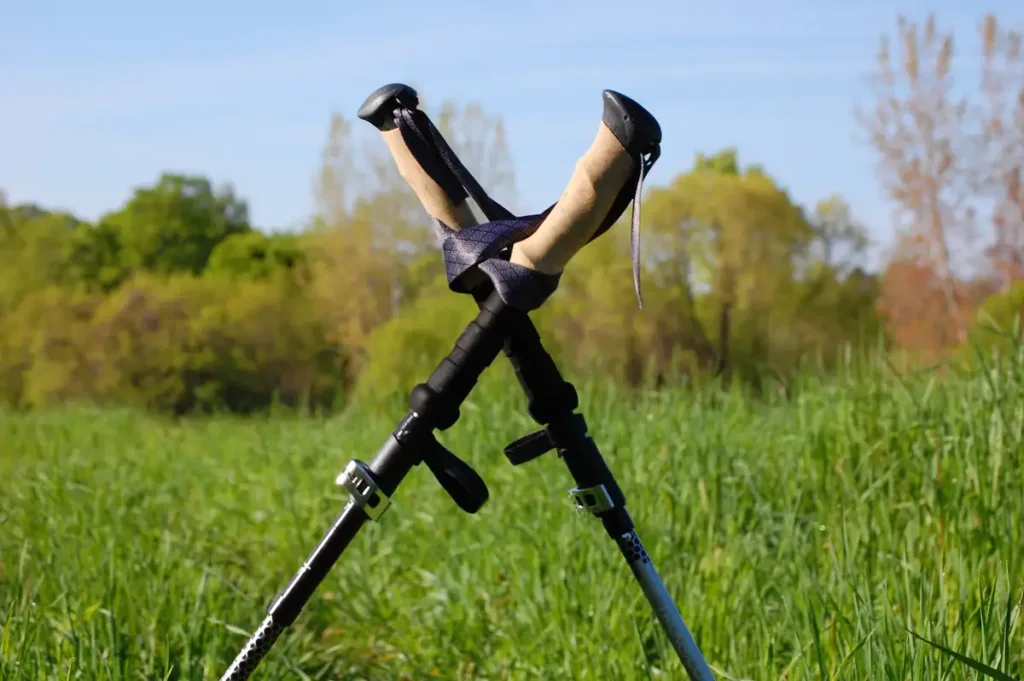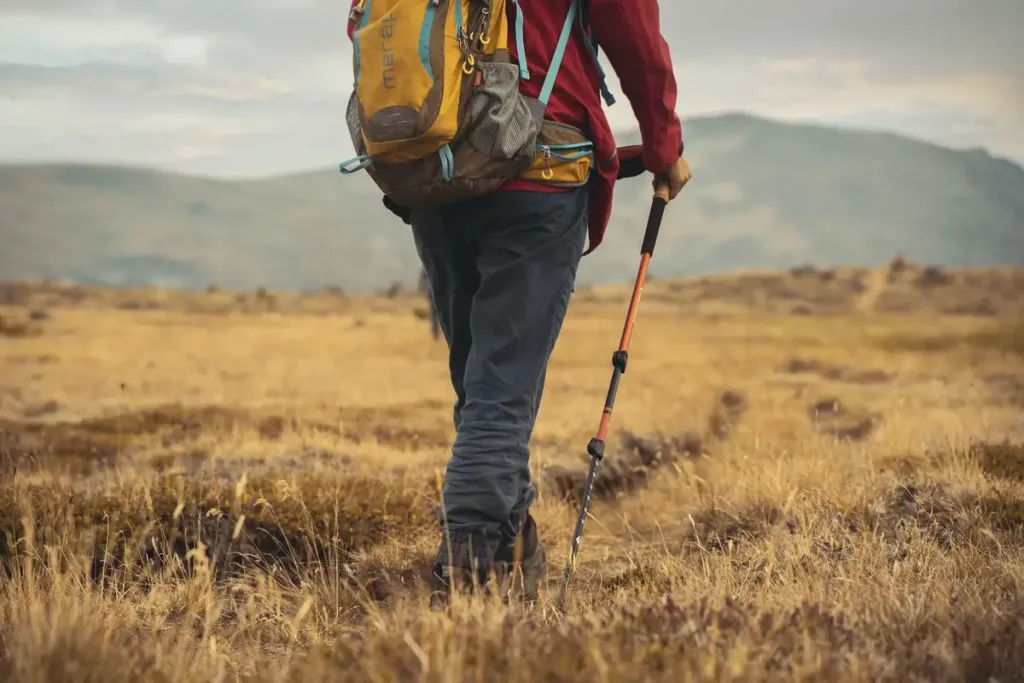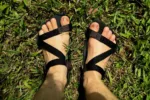Should you use trekking poles for ultralight hiking?
This post may contain affiliate links. This means that we may receive a small commission from purchases through those links. Read more in our affiliate disclosure.
Out there on the trail, we’re all seeking to go further, lighter, and faster. One piece of gear sparks a great debate among ultralight hikers: trekking poles. Are they a valuable tool to aid your journey, or just an unnecessary burden? Let’s tackle this stick(y) issue, one stride at a time.
While trekking poles might seem like extra weight, they can provide invaluable benefits such as enhancing stability and reducing impact on your joints while walking downhill. However, they limit the use of your hands and (surprisingly) cause you to expend more energy. Their necessity largely depends on individual needs, hiking style, and the terrain. To make an informed decision, understanding what trekking poles are, how they work, and the range of poles available can be pivotal.

- Introduction
- What Are Trekking Poles and How Do They Work?
- How Can Trekking Poles Benefit your Hike?
- Can Trekking Poles Enhance Stability and Balance?
- Do Trekking Poles Alleviate Impact on Joints?
- What’s the effect of Trekking Poles on Hiking Efficiency?
- Drawbacks of Trekking Poles in Ultralight Hiking
- Are Trekking Poles an Unnecessary Weight?
- Do Hiking Poles Limit Hand Usage?
- Do I use more or less energy with Trekking Poles?
- How to use trekking poles?
- How to Choose Trekking Poles for Ultralight Hiking?
- Frequently Asked Questions
- Do Trekking Poles Really Make a Difference?
- Are Trekking Poles Necessary for Ultralight Hiking?
- What Material is Best for Trekking Poles?
- Are Trekking Poles Allowed on Airplanes?
- How Do I Determine the Right Length for My Trekking Poles?
- Can I Use Trekking Poles as Tent Poles?
- Conclusion – So, should I use trekking poles?
What Are Trekking Poles and How Do They Work?
Trekking poles are tools used by hikers, walkers, trekkers, and backpackers to provide support and balance while traversing different terrains. Structurally, trekking poles are typically made of two to three sections, which can be extended or retracted to adjust to a hiker’s height and the terrain. The top of the pole usually has a handle made from cork, foam, or rubber, with a strap to secure it to your wrist. At the bottom, a metal tip provides traction, and most poles come with removable rubber tips for various surfaces and removable “baskets” for use in snow or mud.
These poles function much like a set of extra legs. By distributing your weight more evenly across four points of contact rather than just two, they can help maintain balance, especially on uneven, rocky, or slippery surfaces. They also act as a propulsive aid: with every step you take, you can push off the ground with your poles, helping you to move faster and more efficiently.
What Are the Different Types of Trekking Poles?
When it comes to trekking poles, one size doesn’t fit all. They come in various types, each with its own set of features. Some of the most common types include:
- Adjustable poles: These have a telescopic design allowing you to adjust their length according to your height and the terrain.
- Fixed-length poles: These are non-adjustable, so you need to buy the right length for your height.
- Folding or collapsible poles: These poles fold down smaller than adjustable ones, making them a favorite for ultralight hikers and trail runners.
In addition to the basic structure, you might find poles with shock-absorbing features to lessen impact, or lightweight carbon fiber poles that offer strength without adding weight. Some models also feature interchangeable tips and baskets for different terrains and seasons.
How Can Trekking Poles Benefit your Hike?
When it comes to ultralight hiking, every ounce counts. So, let’s talk about the potential benefits of these additional ounces from trekking poles.
Can Trekking Poles Enhance Stability and Balance?
One of the main advantages of using trekking poles is enhanced stability. With every step you take, you’re essentially balancing on one foot. Throw in a heavy backpack and uneven terrain, and you’re constantly testing your body’s stability. Here’s where trekking poles shine. By providing two additional points of contact with the ground, poles effectively turn you into a four-legged creature, offering a significant improvement in balance. This is particularly beneficial when crossing streams, navigating slippery surfaces, or tackling steep descents.
Do Trekking Poles Alleviate Impact on Joints?
The human body is a remarkable machine, but repeated stress can take its toll, especially on your joints. Each step on a downhill hike puts significant pressure on your knees. Studies suggest that using trekking poles for walking downhill can reduce the compressive force on your knees by up to 25%. That’s a substantial reduction, which could mean less pain at the end of the day and fewer long-term issues with your knees and other joints. On the other hand, while walking on level ground, the impact on the knees is not reduced.
What’s the effect of Trekking Poles on Hiking Efficiency?
With poles, your upper body shares the workload of your lower body. By pushing off with your poles, you can propel yourself forward. This can help you maintain a steady pace, especially on uphill climbs. However, while trekking poles can feel like they make the hike easier, do not actually reduce the amount of energy you use – quite the opposite! Hiking poles make your hike energetically less efficient by engaging your upper body musculature. (More on this below.) Of course, this is good news if you’re looking to lose weight or gain upper body strength!

Drawbacks of Trekking Poles in Ultralight Hiking
While trekking poles do offer some undeniable benefits, there are a few potential drawbacks that you need to consider before making a decision.
Are Trekking Poles an Unnecessary Weight?
One of the guiding principles of ultralight hiking is to carry the lightest gear possible. At first glance, trekking poles may seem like an extra weight. Even the lightest pair of poles can add around a pound to your pack weight. For those who prioritize shedding every possible ounce from their pack, this can be seen as a disadvantage. It becomes a matter of weighing (quite literally) the pros and cons — do the benefits of improved stability, and reduced joint stress offset the added weight?
Trekking poles are the most useful when you carry a heavy load which offsets your center of mass and increases the stress on your lower body. In ultralight hiking, we aim to avoid such a situation from the get-go; the lighter your pack, the less you really need hiking poles.
Do Hiking Poles Limit Hand Usage?
Another point to consider is that trekking poles occupy your hands. This could limit your ability to do other tasks while hiking, like taking photos, navigating with a map or GPS, or simply snacking on the go. Also, in situations where you need your hands for climbing or scrambling over rocks, you’ll need to stow your poles, which can be time-consuming and inconvenient.
Do I use more or less energy with Trekking Poles?
Although using trekking poles can boost efficiency by sharing the workload between the lower and upper body, this can be a double-edged sword. The engagement of the upper body, particularly the arms and shoulders, increases your overall energy expenditure.
This might seem contradictory, but think of it this way: while you’re spreading the effort across more muscles, you’re also using more muscles. This means you’re burning more calories, which might not be what you want on a long-distance hike where energy conservation is key. So, if you’re tackling a multi-day hike with limited food supply, consider this potential increase in energy consumption.
How to use trekking poles?
To get the most out of your trekking poles, you need to use them right – check out this video for a detailed explanation:
How to Choose Trekking Poles for Ultralight Hiking?
If you’ve decided to give trekking poles a shot, the next step is figuring out which poles are right for you. It’s not just about picking the lightest pair you can find. You need to consider a range of features to ensure that the poles meet your needs and preferences.
Which Features Should I Look for?
When selecting trekking poles, pay attention to these key features:
- Weight: As an ultralight hiker, this is a critical factor. Look for poles made from lightweight materials like carbon fiber or lightweight aluminum.
- Durability: The lighter the poles, the more careful you need to be with durability. Carbon fiber is lighter than aluminum, but it’s also more prone to breaking under high stress.
- Adjustability: Adjustable poles allow you to change the pole length to match the terrain, which can be useful. However, they are usually slightly heavier than fixed-length poles.
- Grip Material: Grips can be made from foam, cork, or rubber. Foam is the lightest and absorbs moisture from sweaty hands. Cork molds to the shape of your hands over time. Rubber insulates hands from cold and is durable, but it might cause blisters in warm weather.
- Locking Mechanism: This is what keeps your poles from collapsing while you’re using them. There are several types, such as twist lock or lever lock. Make sure it’s secure and easy to use.
- Shock Absorption: Some poles come with a shock-absorbing feature, which can ease strain on your hands and wrists. However, this feature often adds weight and may not be necessary for everyone.
What Are Some Recommended Trekking Poles for Ultralight Hiking?
The market is full of excellent trekking poles, each with their unique strengths. Here are a few models that stand out in the ultralight category:
- Black Diamond Distance Carbon Z: These are folding, fixed-length poles, known for their lightweight and compact design.
- Gossamer Gear LT5 Three-Piece Carbon Trekking Poles: These are adjustable, very lightweight, and come with a comfortable cork grip.
- Leki Micro Vario Carbon: These folding poles provide a blend of weight, durability, and features. They include an ergonomic grip and an external locking mechanism.
Frequently Asked Questions
Do Trekking Poles Really Make a Difference?
Yes, trekking poles can make a significant difference in your hiking experience. They enhance stability, reduce impact on joints, and can increase hiking efficiency, especially on challenging terrains. However, the benefits can vary based on individual needs and preferences.
Are Trekking Poles Necessary for Ultralight Hiking?
No. While trekking poles have their benefits, they also add to the weight of your pack. Whether they’re a good fit for your ultralight hiking setup largely depends on your personal comfort, hiking style, and the nature of your usual terrains.
If you are relatively fit and not carrying a large backpack, you don’t have to worry about stability – in fact, it can be beneficial to rely on your own body to keep you stable. Likewise, if you have trouble with your knees, you can focus on strengthening your knees instead of relying on trekking poles.
What Material is Best for Trekking Poles?
Carbon fiber and aluminum are the most common materials used in trekking poles. Carbon fiber is lighter and absorbs shock better but can be more brittle under high stress, and tends to be fairly expensive. Aluminum, on the other hand, is slightly heavier but more durable.
Are Trekking Poles Allowed on Airplanes?
It depends on the airline’s policy. Trekking poles are generally not allowed in carry-on luggage due to their sharp points. However, you can usually check them in your luggage. Some collapsible poles might fit in a carry-on bag once dismantled. Always check with your airline beforehand.
How Do I Determine the Right Length for My Trekking Poles?
For most hikers, the right length for trekking poles is the one where your elbows make a 90-degree angle when you’re holding the poles with tips on the ground. Most adjustable poles have length markings to help you find the correct length. If you’re in between sizes, it’s generally better to go for the shorter size.
Can I Use Trekking Poles as Tent Poles?
Yes, many ultralight backpackers use their trekking poles as tent poles. This can reduce the overall weight of your pack. However, you’ll need a tent that’s designed to be set up with trekking poles.
Conclusion – So, should I use trekking poles?
In the end, whether or not you should use trekking poles for ultralight hiking is a highly personal decision. The stability, reduced joint impact, and potential efficiency gains must be balanced against the additional weight and the possible limitations on hand usage. Evaluating your needs, assessing your hiking style, and understanding the terrain you usually traverse can provide invaluable guidance in this decision-making process.




